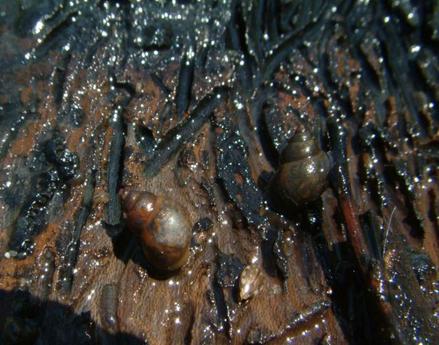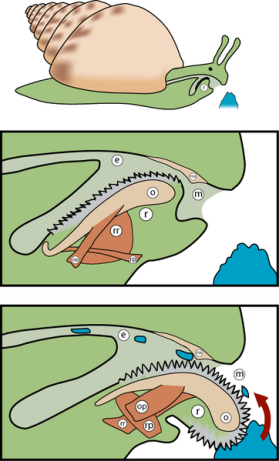
Nutrition
 B. tentaculata has a choice of two avenues to take to feed
themselves.
They can graze on algae using their radula or filter-feed algae
particles out of the water column using their gills (Kipp and Benson
2010). The faucet snail filter-feeds by sucking algae in, condensing it, then
passing it out “between the right tentacle and exhalant siphon in
pellet-like packages” that they then eat (Kipp and Benson 2010). The
faucet snail is known to feed selectively on food of high energy
content and even feed on black fly larvae (Kipp and Benson 2010).
When choosing between which feeding mode to use this snail will
filter-feed when there is increased food concentrations in the water
(Brendelberger and Jürgens 1994). They would choose filter-feeding
because it allows them to be sedentary while feeding giving them a
net energy gain compared to grazing (Wächtler 2001). This net energy
gain can then be used towards the faucet snail's growth or
reproductive goals. Filter-feeding on algae and diatoms led to more
growth than a variety of food eaten by grazing (Wächtler 2001). It
also allows the faucet snail to exist in groups, which lessens
predation and parasitation (Wächtler 2001).
B. tentaculata has a choice of two avenues to take to feed
themselves.
They can graze on algae using their radula or filter-feed algae
particles out of the water column using their gills (Kipp and Benson
2010). The faucet snail filter-feeds by sucking algae in, condensing it, then
passing it out “between the right tentacle and exhalant siphon in
pellet-like packages” that they then eat (Kipp and Benson 2010). The
faucet snail is known to feed selectively on food of high energy
content and even feed on black fly larvae (Kipp and Benson 2010).
When choosing between which feeding mode to use this snail will
filter-feed when there is increased food concentrations in the water
(Brendelberger and Jürgens 1994). They would choose filter-feeding
because it allows them to be sedentary while feeding giving them a
net energy gain compared to grazing (Wächtler 2001). This net energy
gain can then be used towards the faucet snail's growth or
reproductive goals. Filter-feeding on algae and diatoms led to more
growth than a variety of food eaten by grazing (Wächtler 2001). It
also allows the faucet snail to exist in groups, which lessens
predation and parasitation (Wächtler 2001).

However, the ability to switch between feeding modes gives B. tentaculata an advantage by allowing them to grow faster and have better reproductive success (Brendelberger and Jürgens 1994). When the faucet snail grazes for food it moves along substrates and uses its radula or rasp tongue to pick up algae. The radula picks up algae with its rows of renewable chitinous teeth that scrape then grasp the algae (Ghesquiere 2007).
<--- The radula (light pink) is supported by cartilage, called odontophores (red).
<--- The radula (light pink) acts like a conveyor belt bringing food particles from substrate to mouth.
Return to the Home page